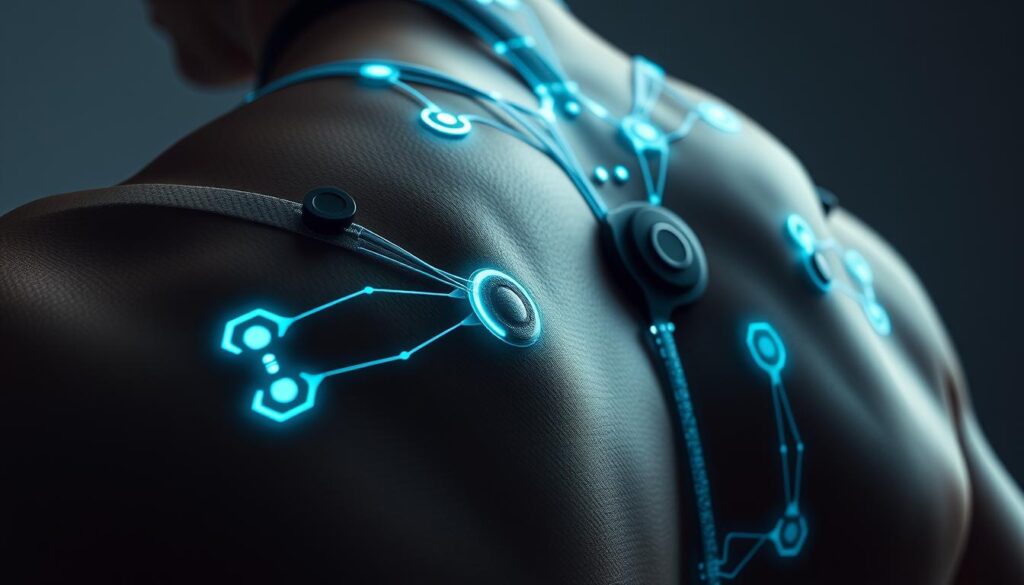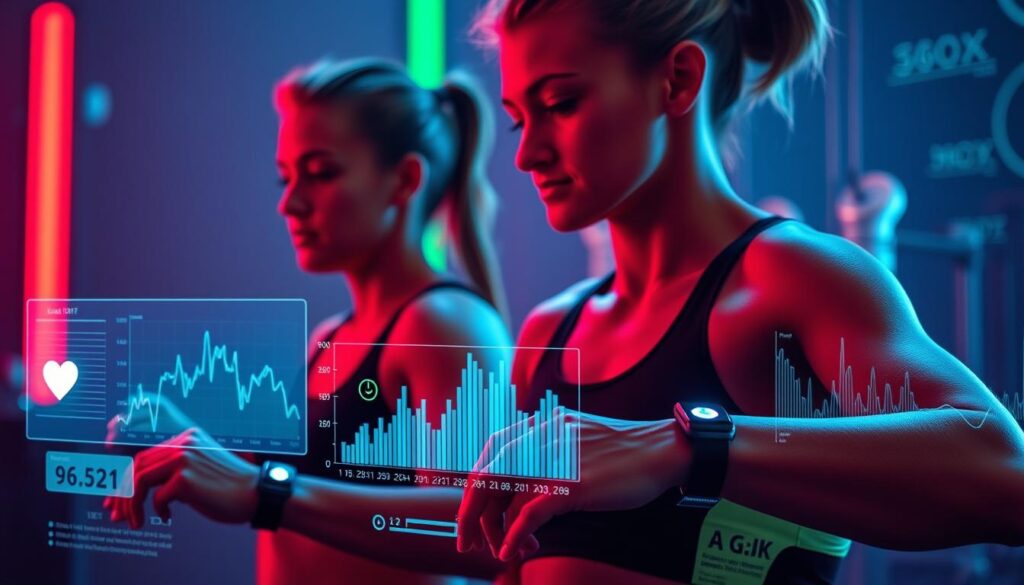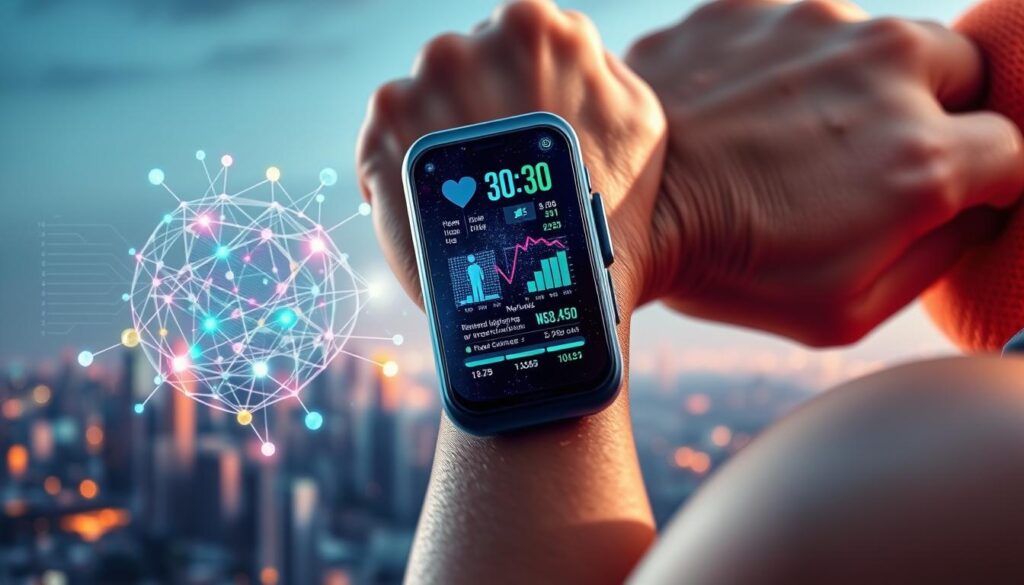When a high school sprinter shaved a hundredth of a second off her time, it began with a tiny code change inside a chip. Coaches had long relied on stopwatches and eye contact, but linking sensors, low‑power radios and on-device models turned raw motion into clear, timely insights.

Today, AI sports analytics and connected sensors blend to give teams and athletes context that goes beyond simple box scores. Edge processing and Bluetooth LE let devices fuse dozens of signals—body motion, ball flight, and equipment response—without draining batteries.
In this article we will explain why this technology matters now, how data moves from sensors to usable insights, which metrics truly change results, and how on‑device models speed decisions during practice and competition.
Key Takeaways
- Edge processing and Bluetooth LE make continuous, low‑power monitoring feasible.
- Combining multiple data streams reveals gains measured in milliseconds and millimeters.
- Wearable performance monitor devices collect and process signals for real‑time action.
- Models surface subtle patterns missed by manual observation during fast play.
- Privacy, reliability, and battery life are essential for field deployment.
Why AIoT wearables matter in sports performance today
Market forces and rising injury rates have pushed adoption of on-body data systems into the mainstream. The global market for sports wearables is projected to reach $249.88 billion by 2030, with a 19.5% CAGR from 2025–2030, which signals broad interest across the sports industry.
Devices now stream real-time movement and physiologic metrics that help teams and athletes spot fatigue, imbalance, and overload. With machine learning and big data, apps detect patterns and anomalies so coaches can intervene before issues worsen.
Timing is critical. Dense schedules and greater competitive pressure make continuous monitoring a tool for immediate adjustments that protect health and boost results within the same session.
- Quantified momentum: Rapid market growth means measurable gains are accessible at youth and pro levels.
- Proactive care: Objective signals shift the model from reactive to preventive, supporting injury prevention and recovery.
- Coach efficiency: Better data helps refine training loads, intensities, and recovery windows in near real time.

| Benefit | Who | Impact |
|---|---|---|
| Real-time alerts | Coaches & athletes | Reduce overload, faster adjustments |
| Pattern detection | Medical staff | Early injury prevention |
| Scalable insights | Clubs & academies | Consistent training quality across budgets |
Industry rollout requires clear governance, privacy safeguards, and interoperability. Those elements let teams deploy solutions at scale while keeping player trust and data secure.
AI sports analytics, IoT player tracking, wearable performance monitor
Modern athlete tracking solutions combine inertial sensors, anchors, and location services to measure parameters in near real time. These systems turn raw motion into usable data that informs coaching decisions and training plans.
The term analytics refers to models that learn from body and ball inputs to grade performance, set benchmarks, and prescribe targeted drills.
IoT player tracking describes the network of beacons and on‑body units that localize athletes on the field, quantify speed changes, and assess movement quality with high accuracy.
![]()
Devices aggregate streams from accelerometers, gyroscopes, magnetometers, and GNSS to capture both mechanics and position. STATSports’ Apex, used by top English Premier League clubs, reports heart rate, distance, sprints, accelerations, impacts, and step balance in match conditions.
- Bluetooth LE syncs processed data to phones and tablets, minimizing latency and power draw so coaches can make informed decisions mid‑session.
- Models improve over time as labeled session and match data increase, boosting metric reliability.
- Football and field sports gain most from positional context, while indoor and individual disciplines focus on movement signatures and speed profiles.
How data flows: from body-worn sensors to real-time insights
A single wrist sensor can begin a chain that turns raw motion into immediate coaching cues.

Sensors on the body—accelerometers, gyroscopes, heart rate and environment units—collect biomechanical and physiological data. Embedded algorithms filter, segment, and extract features before packets leave the device.
Summarized packets travel over low‑latency Bluetooth LE to a phone or web app, then to cloud storage for longitudinal analysis across training cycles. This on‑device preprocessing lowers bandwidth, saves battery, and shortens time to insight.
Reliability safeguards include error correction, adaptive retransmission in crowded venues, and calibration routines that keep tracking fidelity high. Precise sensor placement and sync are essential for valid step counts and event tagging.
Security uses TLS/SSL, authenticated access, and role‑based permissions to protect athlete data. From a single acceleration spike, filters create features, a model tags the event, and dashboards deliver a recommendation to coaches within seconds.
Key performance and health metrics athletes track
A targeted dashboard of internal and external signs helps coaches shape every drill, rest day, and return‑to‑play plan.

Foundational physiology centers on heart rate and heart rate variability. Together they contextualize internal load, readiness, and autonomic balance when paired with external work.
External load includes total distance, current and max speed, sprint counts, accelerations, and decelerations. These metrics map session goals and cumulative workload across microcycles.
Dynamic stress load, impacts, and step balance act as early flags for asymmetry or excessive strain. Those signals often precede fatigue or soft‑tissue issues and guide targeted interventions.
Advanced markers—VO2 max estimates, power output, lactic acid proxies, and muscle fatigue indicators—profile aerobic and anaerobic capacity for individual fitness plans.
- Movement signatures and technical consistency inform skill acquisition and efficiency.
- Integrating internal and external data reveals patterns that shape drill intensity, duration, and recovery.
- Metric choice must match sport demands and an athlete’s role to avoid clutter and improve decision making.
Coaches use these measures to align sessions with tapering, competition, and return‑to‑play milestones for better on‑field results.
Edge AI in action: from raw data to predictive modeling
Local model inference converts many raw sensor streams into compact signals that guide training and risk reduction. Edge devices analyze both historical and real‑time data to surface meaningful patterns that affect preparation and on‑field performance.

Feature extraction reduces multi‑sensor input into lightweight vectors that compact models can classify. Those models quantify intensity, classify movement, and forecast short‑term responses without a network connection.
Training pipelines tune algorithms on labeled session archives using methods like scaled conjugate gradient to speed convergence. Once validated, models deploy to low‑power SoC technology such as Nordic’s nRF54 Series for on‑chip inference.
- Local processing cuts transmission, extends battery life, and supports full‑session analytics.
- Pattern detection flags workload spikes, technique drift, and risky deceleration profiles linked to soft‑tissue stress.
- Edge analytics enables early prevention by recommending adjustments before issues escalate.
Validation ties outputs to match video and longitudinal data to raise accuracy. A continuous feedback loop retrains models from new sessions so teams and the athlete gain better forecasts across a season.
Injury prevention and recovery: smarter strategies with wearables
Small deviations in movement patterns can signal growing fatigue and rising injury risk. Continuous biomechanical analysis surfaces asymmetry, excessive load, or poor form that correlate with higher injury odds.
Systems set alerting thresholds for safe heart rate zones and sudden spikes in decelerations. Those alerts let coaches and staff intervene during training to adjust technique or reduce load.
Recovery intelligence blends sleep quality, HRV, and muscle soreness markers. Together they guide individualized rest days and speed return to full function.
- Prevention strategies: progressive loading plans, technique cues, and constraint‑led drills informed by objective metrics.
- Real‑time workflows: coaches use dashboards to change sets, reps, or drill selection mid‑session to protect athletes while preserving training goals.
- Return‑to‑play guardrails: stepwise load progression and movement quality milestones verified by device metrics.
Successful programs pair data with clear athlete feedback loops and medical collaboration. Simple visual summaries boost adherence and make prevention and recovery part of daily training culture.
| Focus | Metric | Action |
|---|---|---|
| Load | Total work & decels | Reduce volume, adjust drills |
| Recovery | Sleep & HRV | Plan rest day |
| Form | Symmetry & range | Technique cueing |
Real-world use cases across sports
Real deployments show how device data shapes practice plans and game‑day choices across multiple disciplines.
In football, clubs pair positional feeds with inertial metrics to manage workload and spot sudden intensity drops. Elite teams using STATSports combine distance, speed, and heart‑rate zones to time substitutions and adjust training loads.
Ice hockey programs quantify skating speed and shift workload to balance lines during tight schedules. Coaches use shift‑level data to plan recovery between games and keep fitness high across a season.
Basketball staff track jumps, lateral movement, and acute:chronic loads to tune plyometrics and reduce lower‑limb risk. Cricket teams analyze batting swings and bowling mechanics to refine technique and limit repetitive stress.
Swimmers rely on stroke counts, pace, distance, and session duration to structure intervals and improve turns and starts. Ball tracking adds trajectory, spin, and bounce data to assess pass quality and shot accuracy.
- Unified datasets align practice KPIs with competition demands.
- Individualized blocks translate metrics into tailored training for athletes and players.
- Actionable patterns let coaches balance fitness goals with sustainable workload planning.
Under the hood: connectivity, sensors, and chipsets that enable AIoT
A compact mix of sensors, radios, and processors turns motion and physiology into usable signals at the edge.
Modern systems integrate accelerometers, gyroscopes, magnetometers, GNSS/augmented GNSS, and heart monitors inside small devices. This stack supports multi‑modal capture for better accuracy and context during training.
Bluetooth LE offers low energy, stable data rate, and quick pairing with an app and field dashboards. Local SoCs like Nordic’s nRF54 Series add CPU/DSP cores and ML accelerators so feature extraction and inference run on the device.
- Reduced airtime: on‑chip processing sends only critical packets, saving battery and preserving bandwidth in crowded venues.
- Maintenance: calibration routines, drift correction, and sync ensure consistent reads across sessions and extend uptime.
- Durability & security: designs resist sweat, shocks, and temperature swings while TLS/SSL and strong authentication protect heart and movement data.
Facilities often use 5G backhaul for bulk uploads and fleet management, complementing Bluetooth LE for real‑time needs. Together, this technology keeps data flowing with the reliability teams expect in live field environments.
From data to decisions: apps, algorithms, and implementation
A clear workflow turns raw sensor signals into timely coaching actions on and off the field.
Start with a four‑step chain: collect data via accelerometers, gyroscopes, and heart monitors; transmit and store wirelessly to a phone, computer, or cloud; analyze with machine learning and big‑data algorithms; then share actionable feedback so coaches adjust plans.
Security matters: encrypt connections with TLS/SSL, enforce access control, and keep audit trails for compliance.
- Sensor selection and pilot testing.
- App configuration, dashboard design, and staff training.
- Analytics pipelines that convert raw tracking data into readiness scores, risk flags, and drill‑level evaluations.
- Feedback loops that let coaches make informed decisions and personalize training.
UI/UX should offer role‑based views for coaches, athletes, and medical staff, with configurable alerts aligned to team strategies. Start with a core KPI set, validate against video and outcomes, then expand features as trust grows.
Efficiency tips: automate reports, sync with calendar tools, and run monthly model reviews to update thresholds, recalibrate sensors, and drive continuous improvement.
“Good tools surface clear insights that let coaches act fast and protect athlete health.”
Conclusion
Local processing and secure pipelines let staff act on movement and heart data within a single session. This shortens the loop from event to insight and supports faster adjustments that protect athletes and boost training results.
Practical wins include early detection of risky patterns, tailored recovery plans for muscle and fatigue, and clearer return‑to‑play checks that reduce injury and speed recovery.
Across football, court, and endurance domains the same technology adapts KPIs and models to fit sport demands. Teams must guard heart and movement data with TLS/SSL and strict access controls to keep trust high.
Start small: pick a few clear KPIs, validate models, maintain sensors, and iterate. Do that and the industry can scale tools that truly improve athlete health, training, and long‑term performance.
FAQ
What is a wearable AIoT sports performance tracker for athletes?
A wearable AIoT sports performance tracker combines body sensors, wireless connectivity, and on-device intelligence to collect and analyze movement, heart rate, and workload data. Athletes and coaches use it to measure speed, acceleration, muscle load, and recovery metrics in real time, enabling smarter training decisions and injury risk reduction.
Why do wearables matter in performance today?
Modern wearables turn physiological and motion signals into actionable insights. They reveal fatigue patterns, session load, and readiness so teams can adjust training volume, manage recovery, and improve conditioning. This helps improve consistency, reduce overuse injuries, and optimize game-day preparation.
How do analytics and connectivity work together in these systems?
Sensors capture raw signals—accelerometers, gyroscopes, ECGs—and stream them via Bluetooth or LTE to edge processors or cloud services. Algorithms clean and fuse the data, producing metrics like sprint count, heart rate variability, and workload scores, which appear in apps for coaches and athletes.
What does the data pipeline look like from sensors to insights?
The pipeline starts with sensor capture, then signal filtering and event detection on a chipset, followed by feature extraction and model inference either on-device or in the cloud. Finally, visual dashboards and alerts deliver recommendations for training, load management, and recovery.
Which performance and health metrics are most valuable?
Key metrics include heart rate, heart rate variability, sleep quality, training load, sprint distance, acceleration profiles, and muscle strain indicators. These measures help monitor cardiovascular stress, neuromuscular fatigue, and readiness to perform.
What role does edge intelligence play in predictions?
Edge intelligence runs models close to the sensor, lowering latency and preserving privacy. It detects patterns in real time—like abnormal gait or rising fatigue—and triggers alerts or adaptive training cues without constant cloud reliance, improving safety and responsiveness.
How do wearables help prevent injuries and speed recovery?
By tracking workload trends and physiological responses, devices flag sudden spikes or chronic overload that raise injury risk. Combined with recovery metrics—sleep, HRV, muscle oxygenation—coaches can tailor load reduction, rehab exercises, and return-to-play timelines.
Can these systems be used across different sports?
Yes. Devices and algorithms adapt to sport-specific demands—from football and rugby to cycling and track—by tuning event detection and thresholds. Use cases include monitoring impact exposure in contact sports and power output in endurance events.
What hardware and connectivity enable reliable sensing?
Reliable systems use multi-axis MEMS sensors, optical and electrical heart sensors, and low-power SoCs with Bluetooth Low Energy or cellular links. Quality firmware, secure data protocols, and battery management are essential for continuous, accurate capture.
How do apps and algorithms turn data into coaching decisions?
Apps visualize trends, compare session data to baselines, and surface predictive alerts. Algorithms rate injury risk, estimate fatigue, and recommend session intensity. Coaches use these outputs to adjust drills, periodize training, and individualize recovery plans.
What about data privacy and ownership?
Athletes should confirm who owns and can access their data. Look for devices and platforms with clear consent, encryption, anonymization options, and compliance with privacy standards to protect health information.
How accurate are physiological measures like heart rate variability and muscle oxygenation?
Accuracy varies by sensor quality and placement. Chest straps and medical-grade ECGs are most accurate for heart signals; wrist sensors are convenient but can be noisier. Calibration, sensor contact, and validated algorithms improve reliability.
How do teams implement this technology without overwhelming staff?
Start with pilot programs focused on a small set of metrics tied to clear goals—injury reduction or performance gains. Train staff on interpreting dashboards, set automated alerts, and phase rollout to scale adoption without adding excessive workload.
What are common limitations and how are they addressed?
Limitations include sensor noise, battery life, and model bias from limited datasets. Address them with better hardware, signal-processing techniques, frequent firmware updates, and diverse training data to improve generalization.
Which vendors and platforms are reputable in this space?
Choose established brands with peer-reviewed validation, enterprise support, and strong security practices. Evaluate product trials, integration with existing athlete-management systems, and evidence of improved outcomes in real deployments.
Transform Your IoT Vision Into Reality.
Get free expert insights, architectures & cost breakdowns.
Drop your email to schedule free meeting.